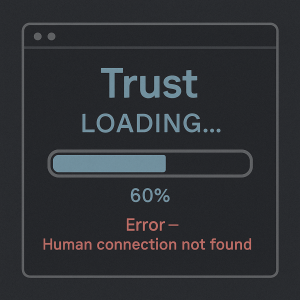
Trust is the cornerstone of every high-performing team.
But as automation and AI increasingly power our workflows, there’s a quiet risk emerging in many tech-driven environments, a growing emotional distance between people.
And when people feel like they’re just another node in a system, trust doesn’t just erode slowly. It disappears fast.
The Hidden Cost of Automation in Human Teams
Automation isn’t the enemy. In fact, done right, it unlocks speed, accuracy, and efficiency. But in our rush to digitise every process, something deeply human is being left behind: connection.
Think of the last time a chatbot failed you. Or when a project status update was auto-generated with no context.
Helpful? Maybe.
Human? Not at all.
Now scale that across a team. A team where:
- Managers rely on dashboards but forget the check-ins
- Feedback is automated but not meaningful
- Recognition comes from software, not people
Suddenly, the heartbeat of the team weakens. Morale dips. Friction rises. And trust? It’s nowhere to be found.
Where AI and Automation Create Distance
Here are the key areas where automation can unintentionally damage trust within tech teams:
- Communication Becomes Transactional
Automated emails, templated Slack responses, and scheduled messages can all be useful, but they can’t replace authentic dialogue. - Feedback Feels Generic
Performance reviews or surveys generated by algorithms may check a box, but they rarely create the safe space needed for real development. - People Feel Monitored, Not Supported
Tools that track productivity metrics may be well-intended, but without transparency and context, they often breed fear instead of accountability. - Collaboration Gets Streamlined to Death
When everything is about tickets, trackers, and turnaround times, the nuance of ideas and the richness of relationships get flattened. - Recognition Lacks Meaning
Auto-generated “kudos” and gamified badges may offer a dopamine hit, but they don’t substitute for genuine appreciation from a peer or leader.
Keeping the Human in the Machine
So, how do we use automation without losing connection?
- Lead with empathy, not just efficiency
Start every project with real conversations, not just tools. Understand people’s motivations, not just their KPIs. - Balance data with dialogue
Let dashboards inform your leadership, not replace it. Check in face-to-face (or screen-to-screen). Listen more than you automate. - Design tech to serve relationships, not replace them
Choose tools that encourage collaboration, not just reporting. Opt for solutions that create visibility and foster belonging. - Recognise the irreplaceable
Automated insights can flag performance, but only leaders can nurture potential. Make space for that.
In Tech Teams, Trust Must Be Built, Not Programmed
You can’t code your way into trust.
You can’t plug in a quick fix.
And you definitely can’t “set it and forget it.”
Trust is built in the micro-moments:
A thank-you said out loud.
A concern taken seriously.
A decision explained transparently.
These are human inputs.
And they’re non-negotiable in high-trust, high-performance teams.
Final Thought
The future of work isn’t less human, it’s more human, amplified by tech.
Leaders who get this will build cultures where innovation thrives, loyalty deepens, and people bring their best.
So before your team automates the next process, ask: Are we connecting, or are we just completing tasks?
Let’s not confuse progress with presence.
